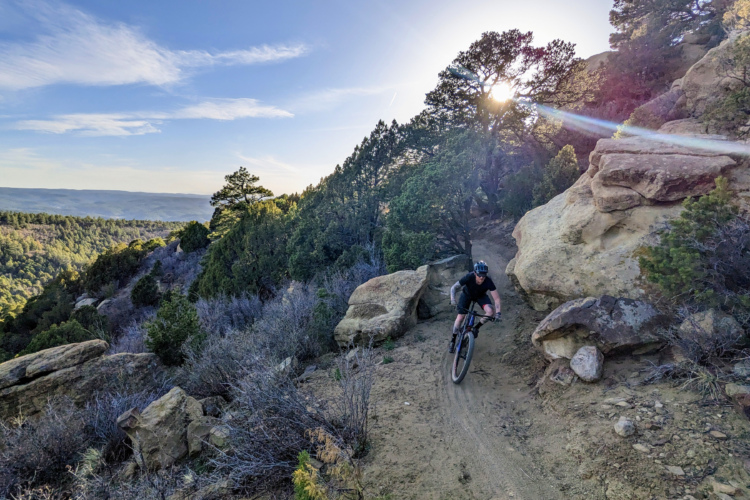
The Boulder Valley Ranch (BVR) is a parcel of open space land located north of the City of Boulder and west of Boulder Reservoir, on the east side of Highway 36. This open space is home to a network of trails lacing a working agricultural area used for cattle grazing at certain times of the year.
The trails wind around high on a mesa and then descend a short, steep hill to the shores of the reservoir below. While this isn’t the dramatic terrain you might think of as quintessential “Boulder,” the views of the mountains are beautiful — and it’s home to the Boulder Mountainbike Alliance’s latest trail access win.
On November 21, 2024, for the first time in 26 years, 5 months, and 15 days, a trail in the BVR was opened to mountain bikes: the Cobalt Trail.
In the fall of 2024, Timberline Trail Craft, in conjunction with the Boulder Mountain Bike Alliance (BMA), worked to reroute and improve the Cobalt Trail with a few objectives in mind:
- Make it accessible to adaptive mountain bikes.
- Make it flowier and more sustainable so mountain bikes can have an enjoyable descent off the top of the mesa down to the reservoir below.
- Improve sustainability for all trail users, whether they’re on tires or feet.
The end result is a flowy trail with a mellow grade that’s about four feet wide. The rebuilt trail tread features low berms and plenty of rollers and grade reversals to shed water.

Critical connectivity created by the Cobalt trail
Even though Cobalt is just one mile long, the rebuild makes Cobalt the best way to reach the Boulder Reservoir from the mesa above, providing critical connectivity through this area. While the Eagle trail already provided legal access, this old road grade was steep and filled with baby-head-size rocks — completely out of character with the other trails in the area. Cobalt’s new bike-optimized flow is a whole different story.
Riders can use a variety of trails to pedal from downtown Boulder to access the BVR via an underpass beneath Highway 36. At the underpass, Cobalt also connects to the North Sky trail.
For a longer ride, “you can go under the highway and do a loop with North Sky, which is almost four miles long,” said Wendy Sweet, Executive Director of the BMA. “It’s a little tricky to get back across the highway at Neva Road because there’s not an underpass, so you kind of have to play Frogger. But then you can do a bigger loop than just out-and-backs on either the west side or the east side of Highway 36.”
More trail connectivity is in the works thanks to the North Trail Study Area management plan, and riders can piece together even longer routes — now with less road riding than ever before.
While the trails are great for beginner mountain bikers, this interconnected network of trails, paths, and roads is also perfect for multi-surface gravel rides. “The gravel bikes are out in force, for sure, in Boulder Valley Ranch, and it connects really well to the unpaved roads that they also use,” said Sweet.

History of the Boulder Valley Ranch Redesign Project
The rebuild of the Cobalt trail is just the first project in a larger effort known as the Boulder Valley Ranch Redesign Project. Work leading up to the BVR Redesign Project “really kicked off in 2004 when BMA started participating in other City of Boulder Open Space management plans, which led to this management plan, which BMA was able to help build because we have a Trails Program Director, Mike Rutter, on staff,” said Sweet. “It took a long time to get here, even if the end result doesn’t seem as exciting as other places offer.”
Through the BVR, the City of Boulder is striving to improve access and accessibility — especially for adaptive riders. “They realized they could make it more accessible by optimizing the trails for adaptive bikes, which also makes it more fun for regular bikes. And that’s just adding berms and grade reversals,” said Sweet. “It’s not a bike park by any means, and all the trails are green level, but just giving a little bit of flow and interest to trails that lacked that before.”
The City is also trying to “deal with some non-system trails and improve the trails were not very sustainable.”

Future improvements coming in the redesign project
The rebuild of the Cobalt trail was just the first step in the redesign project. The BMA is gearing up to rework the Degge and Hidden Valley trails in 2025. Following the rebuilds, both of these trails — which are currently closed to bikes — will also open to wheeled traffic.
In addition, the project also calls for the adoption of some of the non-system trails into the trail system, with modifications made in certain places to improve sustainability. While some non-system trails will be closed to reduce habitat fragmentation, the Redesign Project is culminating in a notable increase in mountain bike trail access in a network that hasn’t seen a new trail opened to bikes in a staggeringly long time.











1 Comments
Dec 18, 2024